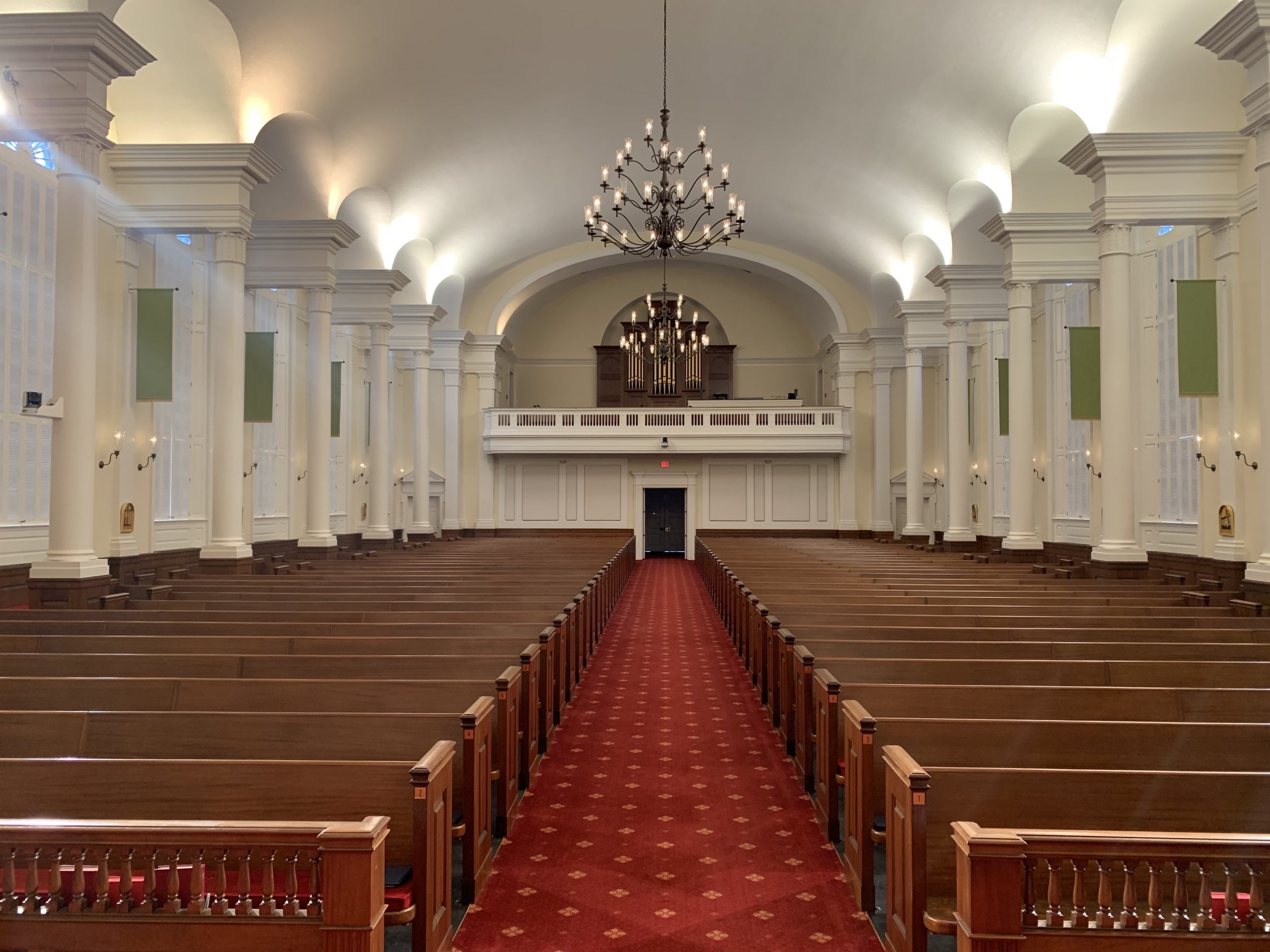Symbolism in the Sanctuary
The Christian is directed to “ascend unto the Hill of The Lord.” In our Sanctuary, this is symbolized by a series of rising steps that continue until one reaches the Holy Table. Starting at street level, the first four steps represent the Cardinal Virtues of Justice, Prudence, Temperance, and Fortitude. Next in order are the Three Elements of Man: Body, Soul and Spirit. This is followed by the Three Theological Virtues of Faith, Hope and Charity. To this point, man is surrounded and influenced by the two groups of virtues. The result is symbolized in the next three steps typifying the Three Elements of Faith – Knowledge, Assent, and Confidence – through which one takes the last step into the One Church and thus enters the Divine Mystery.
Over the center door there is the carving of the Agnus Dei, The Lamb of God, having under His feet the Book of Life with its seven seals as described in the Revelation of St. John the Divine.
In the early Church, the unbaptized were admitted only part of the way into the church. An existing example of this practice is found in the great Atrium of the church of Saint Ambrogio in Milan. The Narthex symbolizes this area.
The plan of the church itself recalls the Roman law courts or basilicas after which, beginning in the fourth century, the large churches were patterned. The word “basilica” in Greek means “kingly” and it is particularly appropriate that buildings for the worship of the King of Kings should be reminiscent of the buildings called by that name. In the Roman basilica there was a great hall lined with columns where the populace assembled; this was called the nave. At one end was the apse, a semi-circular extension containing the altar on which sacrifices were made to the gods at the opening of the courts. In the center of the rear was the seat of the principal judge and on either side were those of the minor judiciary. It is easy to see how this has been adapted and, with the addition of Transepts, the plan was changed to represent the cross itself. In this way the pagan law court became the Christian temple.
The architectural style used reminds one of our Founding Fathers who came to this country for religious freedom, bringing with them an adaptation of English Georgian. The resulting American Colonial has been further modified by changing tastes over the years until it can properly be called Modern Colonial.
As one approaches the Chancel, he sees on one side the Lectern from which the very word of God is read, and on the other the Pulpit from which comes instruction in the divine truth.
Our Lectern is small compared to the Pulpit, but the awesome majesty of the divine word is sufficient to create its own importance. The front of the Lectern is carved and portrays the Old Testament by the Tables of the Law and the New Testament by the Anchor Cross.
The Pulpit is approached from the Chancel by seven steps to mark the perfect life and teaching of the Christ. On its front, the Pulpit is carved and shows the Cross and the four rivers, treated heraldically, to symbolize the teaching of the Cross as triumphant to the four corners of the earth.
From the Nave floor one ascends again toward the Holy Table. One step is at the Communion Rail, symbolizing the step taken in kneeling to receive the symbols of the body and blood of Our Lord in complete submission. Once this step is made, one sees six steps beyond representing the attributes of the Deity: Power, Majesty, Wisdom, Love, Mercy, and Justice. Together there are seven steps. Seven ancient creeds represent perfection; to us they lead to the symbol of the perfect sacrifice.
The focal point of attention is the Holy Table itself. When it is not fully appareled the carving in the front may be seen. This shows the Christ in Greek. It is surrounded by the symbols of the Four Evangelists, and by the Vine. The winged Man represents Saint Matthew who teaches the incarnation of the Son of God. The winged Lion is for Saint Mark who tells of the royal character. The Eagle stands for Saint John who writes of the divine nature. The winged Ox marks the story of the sacrifice as told by Saint Luke. The Vine is taken from Christ’s own words as to our relationship with Him and, as a circle, shows the perfection of His sacrifice for us. Five crosses are carved on the Mensa to symbolize the five wounds in His body at the Crucifixion. The whole is surmounted by the empty cross, the symbol of the risen Savior, and six office lights, the traditional number since earliest times.
When the altar is fully appareled, it is covered with the Fair Linen symbolizing His linen wrappings in the tomb and a frontal richly embroidered as becomes kingly robes. The green frontal shows again the Agnus Dei -The Lamb of God slain for the sins of the world. It is powdered with Greek crosses embroidered in gold symbolizing that Christ is come to the Gentile as well as the Jew. Fleur-de-lis in the super frontal remind one of the entire Triune God. The over-all color of green symbolizes our growth in the love and knowledge of our Lord. The silk used is the Salisbury pattern having in it both the fleur-de-lis and the rose, Christ being the Rose of Sharon and the Lily of the Field.





